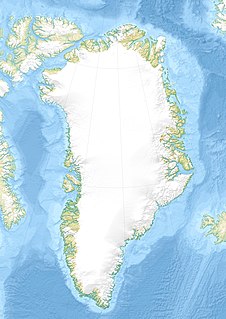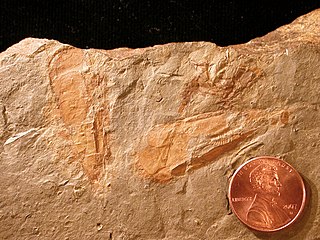
Dalmanites is a genus of trilobite in the order Phacopida. They lived from the Late Ordovician to Middle Devonian.

Paradoxides is a genus of large to very large trilobites found throughout the world during the Mid Cambrian period. One record-breaking specimen of Paradoxides davidis is 37 cm (15 in). It has a semicircular head, free cheeks each ending with a long, narrow, recurved spine, and sickle-shaped eyes, providing almost 360° view, but only in the horizontal plane. Its elongated trunk was composed of 19-21 segments and was adorned with longish, recurved lateral spines. Its pygidium was comparatively small. Paradoxides is a characteristic Middle Cambrian trilobite of the 'Atlantic' (Avalonian) fauna. Avalonian rocks were deposited near a small continent called Avalonia in the Paleozoic Iapetus Ocean. Avalonian beds are now in a narrow strip along the East Coast of North America, and in Europe.

Huntoniatonia is genus of trilobites, an extinct group of marine arthropods of average to large size.

Olenelloides armatus is an extinct, small sized olenelloid redlichiid trilobite arthropod. It lived during the later part of the Botomian stage, which lasted from approximately 524 to 518.5 million years ago. This faunal stage was part of the Cambrian Period. The most conspicuous feature is the hexagonal head shield that carries 6 ray-like spines..

Wanneria is an extinct genus from a well-known class of fossil marine arthropods, the trilobites. It lived during the later part of the Botomian stage, which lasted from approximately 524 to 518.5 million years ago. This faunal stage was part of the Cambrian Period. Wanneria walcottana is the only known species in this genus.
Elliptocephala is an extinct genus from a well-known class of fossil marine arthropods, the trilobites. It lived from the later part of the Tommotian to the upper Botomian. Elliptocephala can easily be confused with Ellipsocephalus, a trilobite genus of the Ptychopariida order.
Fremontella is an extinct genus from a well-known class of fossil marine arthropods, the trilobites. It lived during the part of the Toyonian stage. This faunal stage was part of the Cambrian Period. Fremontella shares with the other genera of the Bristoliinae subfamily, Lochmanolenellus and Bristolia conspicuous and long curved spines on the headshield. These reach back equal to 4-5 thorax segments. The furrows that separate border, eye ridges, glabella and its lobes are distinct. The area outside of the axis of the third segment of the thorax is enlarged, and carries large trailing spine on each side.

Nephrolenellus is an extinct genus of trilobite, fossil marine arthropods, of relatively small size. Currently two species are attributed to it. Nephrolenellus lived at the end of the Lower Cambrian. Species are known from the Great Basin of California, Nevada and Arizona, with one specimen from Canada.
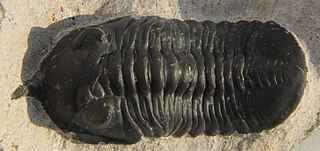
Morocconites malladoides is an average size trilobite, which lived during the Devonian period, in what is now southern Morocco. This species is assumed to be a close relative of Acastoides. The most conspicuous feature is the very long upcurved frontal medial spine, a bit like an avocet bill. It is the only known species in this genus.

Peachella is an extinct genus of trilobites, fossil marine arthropods, with species of average size. It lived during the Toyonian stage, 516 to 513 million years ago, in what is today the southwestern United States. It can easily be distinguished from other trilobites by its club-like genal spines.
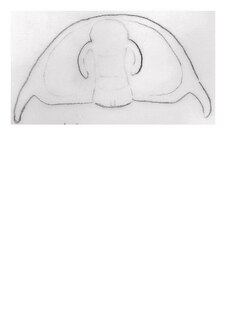
Eopeachella is an extinct genus of trilobites, fossil marine arthropods, with species of probably small size, entire, articulate specimens have not yet been found. It lived during the Toyonian stage, in what is today the South-Western United States. Eopeachella angustispina is the only known species in this genus.

Ptychoparia is a genus of ptychopariid trilobites, and is the type genus of the family Ptychopariidae, and the order Ptychopariida.
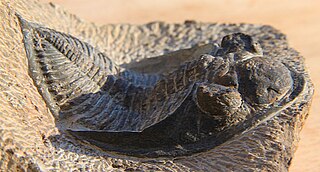
Odontochile is a genus of trilobites in the order Phacopida, family Dalmanitidae.

The Bristoliinae is an extinct subfamily of trilobites, fossil marine arthropods, with species of small to average size. Species belonging to this subfamily lived during the Botomian and Toyonian stage (Olenellus-zone), 522-513 million years ago, in the former continent of Laurentia, including what are today Mexico, the Appalachian Mountains and the south-western United States, and Canada.
Lochmanolenellus is an extinct genus of trilobites, fossil marine arthropods, with one small species, L. mexicana. It lived during the Botomian stage (Olenellus-zone), 522–513 million years ago, in the South-West of the former continent of Laurentia, in what are today Mexico, and the South-Western United States.

Bristolia is an extinct genus of trilobite, fossil marine arthropods, with eight or more small to average size species. It is common in and limited to the Lower Cambrian shelf deposits across the southwestern US, which constitutes part of the former paleocontinent of Laurentia.
Bolbolenellus is an extinct genus of trilobites, fossil marine arthropods, with five species attributed to it currently. It can be easily distinguished from all other trilobites by the combination of the absence of dorsal sutures in the head shield like all Olenellina, and a distinctly bulbous frontal lobe (L4) of the raised axial area in the head called glabella. The species lived at the end of the Lower Cambrian.

Geragnostus is a genus of very small agnostid trilobites whose fossils are found Ordovician-aged marine strata from Eurasia, North America and Argentina.

Viaphacops is a genus of trilobites in the order Phacopida, family Phacopidae, that lived during the Middle Devonian, and is known from North and South America, Asia.


